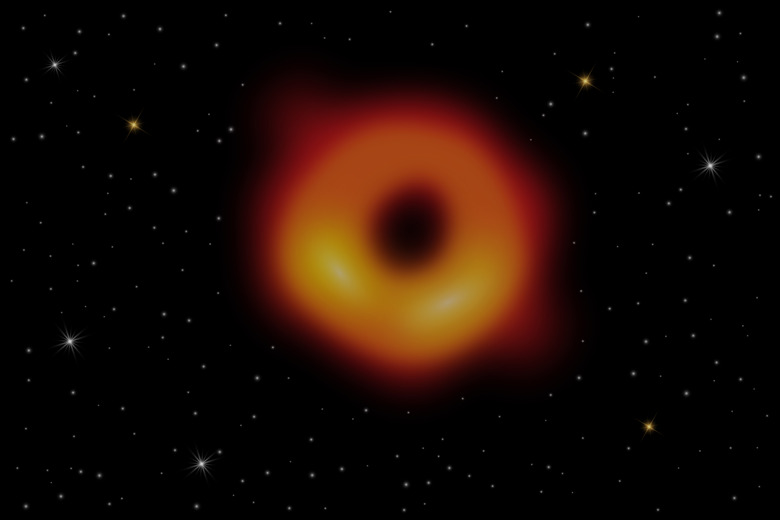Massive Black Hole Breaks Current Physics Theories
Astronomers may have discovered a massive black hole that is about 68 times larger than the sun. Current physics models don't support the existence of a black hole this size in the Milky Way galaxy, so the discovery is raising many questions. Several scientists have come forward and published papers that challenge the astronomers' claim.
Research on Black Holes
Research
on Black Holes
Black holes aren't empty space. Instead, they have an enormous amount of matter and are dense. Black holes also have strong gravitational fields, so light can't escape them.
According to NASA, Einstein's theory of general relativity included a prediction about black holes. Einstein believed a black hole formed when a large star died. The star's dense core had to be about three times larger than the mass of the sun for gravity to make it collapse and create the black hole. The black hole could grow over time as it absorbed dust, gas and other things around it.
Stellar mass black holes, which are usually 10 to 24 times bigger than the sun, form when a star collapses on itself. Astronomers aren't sure how supermassive black holes, which can weigh millions of times more than the Sun, form in the universe. But they may exist at the center of galaxies.
The New Discovery
The
New Discovery
Chinese astronomers believe they have discovered a stellar mass black hole in the Milky Way galaxy that is only 13,800 light-years from Earth. The team of researchers used China's Large Sky Area Multi-Object Fiber Spectroscopic Telescope (LAMOST) to find a blue star that they named LB-1. They noticed the star was orbiting another object that they believe is a black hole.
The Chinese team believes their discovery is about 68 times bigger than the sun, so it's much larger than other stellar mass black holes. According to current physics theories, black holes in the Milky Way galaxy shouldn't be bigger than about 30 suns.
ScienceNews reports that the Chinese team has proposed several ideas for how the stellar mass black hole formed in the galaxy. One possibility is that a failed supernova helped create it. If a star lacked enough energy to explode completely, some of its gas might have come back into the black hole. Another possibility is that two stars helped make the black hole.
Questions About the Research
Questions
About the Research
Several scientists have raised questions about the Chinese team's work. Three separate papers refute the possibility that a stellar mass black hole of 68 solar masses could exist in the Milky Way. The Chinese team has admitted that the calculations need to be checked.
The Chinese researchers point out that the calculations for the black hole's mass depend on having the correct distance to LB-1. Based on LB-1's brightness, they think it's 13,800 light years away. However, the Gaia satellite's data doesn't match their calculations for the distance to the star.
The scientists who disagree with the Chinese team's claim point out that the black hole probably has a much lower mass. They think it may be about five to 20 solar masses, which would make it a normal size for the Milky Way. In addition, they believe that the LB-1 star is about 7,000 light-years away instead of 13,800 light years.
Nevertheless, the black hole probably does exist and could still be an interesting object to study in the future.
References
- National Geographic: Extreme Black Hole Vindicates Einstein (Again)
- CNET: Ultramassive Black Hole Makes Our Sun Look Like a Lightweight
- Nature: A Wide Star–Black-Hole Binary System from Radial-Velocity Measurements
- Cornell University: Weighing in on Black Hole Binaries with BPASS: LB-1 Does Not Contain a 70m Black Hole
- Cornell University: No Signature of the Orbital Motion of a Putative 70 Solar Mass Black Hole in LB-1
- Cornell University: Not So Fast: LB-1 Is Unlikely to Contain a 70 M Black Hole
- NASA: Black Holes
- ScienceNews: A newfound black hole in the Milky Way is weirdly heavy
Cite This Article
MLA
Bandoim, Lana. "Massive Black Hole Breaks Current Physics Theories" sciencing.com, https://www.sciencing.com/massive-black-hole-physics-13723452/. 16 December 2019.
APA
Bandoim, Lana. (2019, December 16). Massive Black Hole Breaks Current Physics Theories. sciencing.com. Retrieved from https://www.sciencing.com/massive-black-hole-physics-13723452/
Chicago
Bandoim, Lana. Massive Black Hole Breaks Current Physics Theories last modified August 30, 2022. https://www.sciencing.com/massive-black-hole-physics-13723452/
